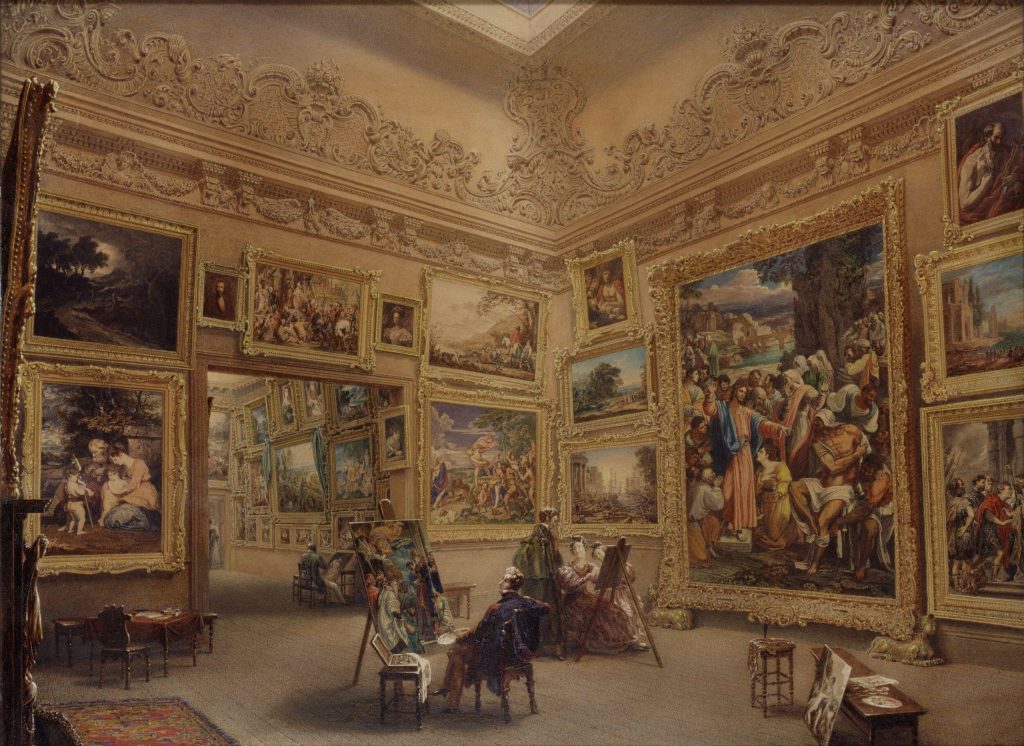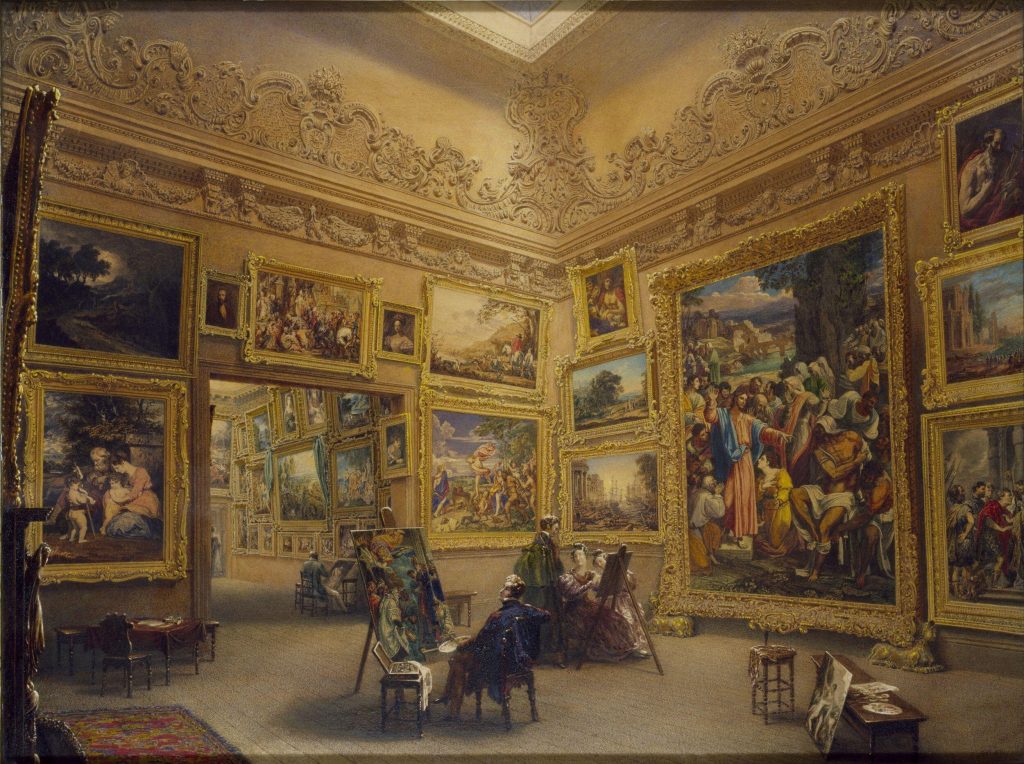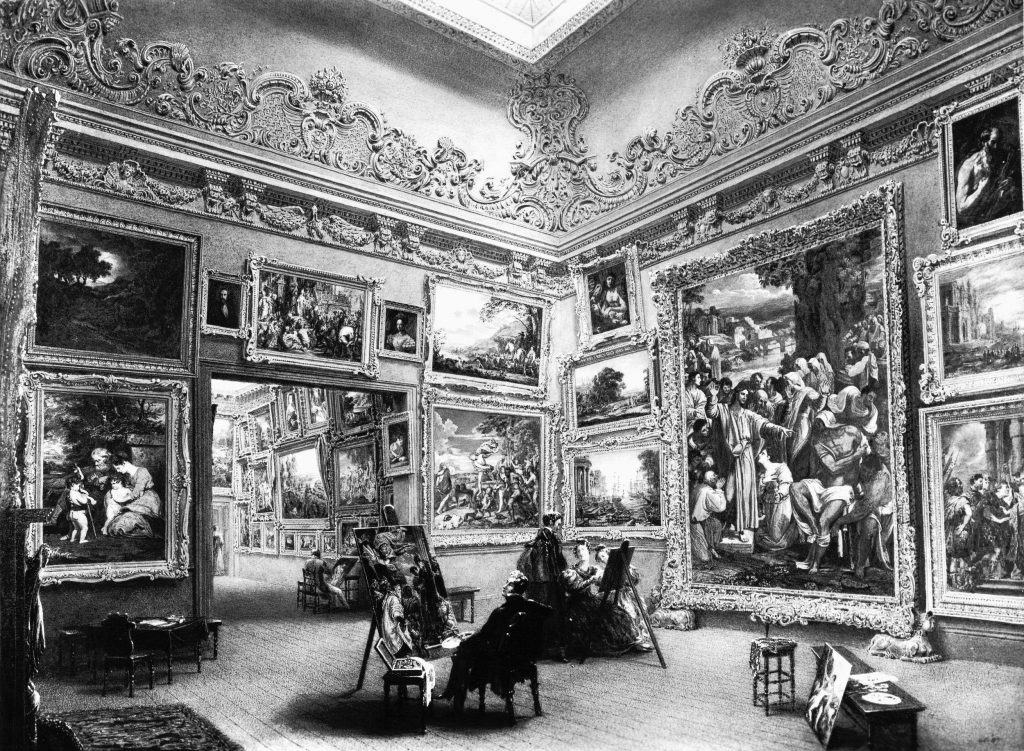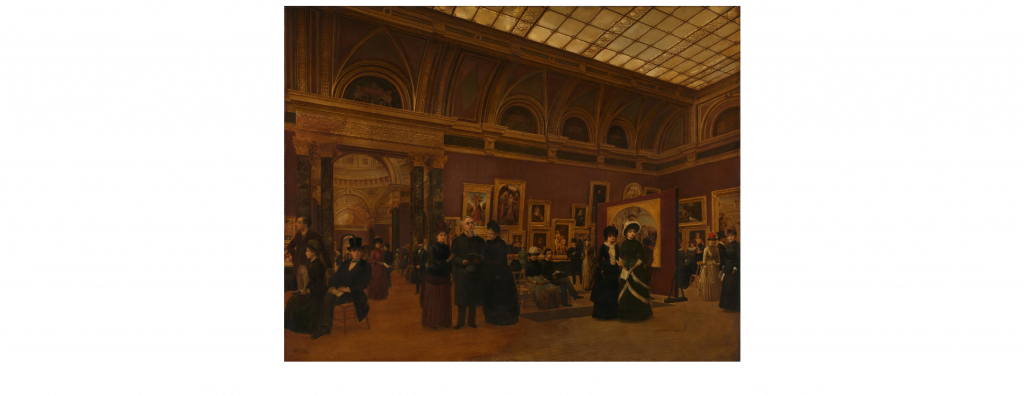What should the museum provide: comfort or contemplation? Individual freedom or public decorum? Education or entertainment? These are the questions that Joel Sanders and Diana Fuss pose in the article “Notes from the Museum Bench“1. In the midst of the debate on the functions of the museum, redefined at the last ICOM general assembly in addition to the traditional tasks of researching, collecting, conserving, interpreting and exhibiting tangible and intangible heritage, museums must be accessible and inclusive, have the participation of different communities and promote diversity and sustainability.
Based on these premises, the artist Raquel Friera investigates the birth of national galleries in Europe in the mid-19 th century, a moment in history that shared some of these concerns. Now, that moment and those concerns have been overshadowed by the exclusive debate based on the white cube.
Friera takes Charlotte Klonk’s study, Spaces of Experience2, as a reference, in which she explains how the founding of national galleries in Europe, and the transition from private to public collections, runs parallel to the development of the notion of individuality and, at the same time, to a change in the conception
of the works and the spectators. It should be noted that, at that time, the figure of the spectator was already restricted and exclusive: the spectator identified itself with the liberal notion of the citizen that, at that time, was defined as those who had the right to vote (basically middle-class men) and which therefore excluded women and working class people. Through this work by Raquel Friera, we could then ask ourselves what exclusions the figure of the spectator in today’s museums involves.
Le Salon carré en 1861, © 2010 RMN-Grand Palais (musée du Louvre) / Stéphane Maréchalle
In the mid-19 th century, the museum was understood as a public space in the same way that a park was. This accessibility meant that it soon experienced a notable influx of visitors with the friction that this entails in its work of preserving and contemplating works of art. As the museum manager explains in the Report and Minutes from the Select Committee on the National Gallery (1850), which forms the basis of work for Raquel Friera’s performance:
“I have seen that many people use it [the National Gallery] as a space for eating, for cooling off and for meetings… I have observed many things that show that many people who come, do not really come to see the paintings. On one occasion, I saw some people, who seemed to be people from the countryside, with a basket of provisions. They pulled out chairs and sat down, and they seemed to be very comfortable, they had food and drink, and when I suggested to them the inappropriateness of such behaviour in a place like this, they responded with good humour, and a lady offered me a glass of gin and wanted to share what they had brought. I explained to them that these things could not be tolerated.”



Images from The National Gallery when at Mr J. J. Angerstein’s House, Pall Mall, by Frederick Mackenzie.

Image from The National Gallery 1886, Interior of Room 32, by Giuseppe Gabrielli.
The large confluence of visitors, who use the museum as a true public space, puts a strain one of its functions, that of the contemplation or enjoyment of art, and encourages the urgency of educating attitudes. In the case of the National Gallery, in its final headquarters in Trafalgar Square, the transformation begins with changes in the furniture and layout of the rooms. Individual pieces of
furniture are abandoned and instead sofas or central benches are used to set out the route through the rooms. In the interview “The white cube and beyond”3, Charlotte Klonk analyses how, since the mid-18 th century, museums understood as accessible public spaces play a role in the cultivation of relationships not only with objects, but also with subjects. In this sense, Klonk asks, “How did the unwritten rules of conduct in museums develop?”. There is no doubt that the interior design and layout of the rooms have contributed enormously to this. The furniture in museum rooms is usually functional and invisible: long benches that allow you to sit perhaps to contemplate iconic works, but not to rest. Sofas and
other more comfortable elements are usually found in museum halls or other transitional spaces. When more comfortable seats or elements are presented (cushions, loungers, etc.), they are usually part of contemporary artistic installations with a predominance of audiovisuals that require another type of
reception. The spatial arrangement therefore went from being “a place of social conversation” to “a space for individual contemplation.” They also prohibited everything other than contemplating and appreciating art (the main activity). We have therefore arrived at a “disembodied contemplation of art”, as Joel Sanders
and Diana Fuss say in the already cited article “Notes from the museum bench”. In fact, from the white cube, a disembodied eye is enhanced, alien to the needs and limits of the body. Following this line of reflection, we can better understand why Sanders and Fuss end up assimilating museums to shopping centres — which do not consider bodies in repose — or to churches — which require an
attitude of withdrawal.4
View of the exhibition Duty-Free Art. Hito Steyerl. Museo Nacional Centro de Arte Reina Sofía. November 2015. Photography: Joaquín Cortés / Román Lores
“Is another type of behaviour possible that is neither devout nor silent?”, Klonk asks.5 Museums continue to be a public meeting space. It should be possible, as Klaas indicates6 , to transform them into non-consumption spaces that allow us to rethink what the notion of res publica means in today’s society.
All this makes Raquel Friera’s look at the “pre-white cube” past very relevant. She quotes Julia Ramírez-Blanco, who states, “In times when the political imagination must be renewed, we can listen to the fantasies and social proposals of the art of past, understanding utopia as a way to open the field of
radical thought to rethink the present.”7
Montse Badia – Raquel Friera
- Sanders, J.; Fuss, D. “Notes from the Museum Bench”. MIXdesign [https://www.mixdesign.online/notes-from-the-museum-bench]. ↩︎
- Klonk, C. Spaces of Experience. Art Gallery Interiors from 1800 to 2000. Yale University Press, New
Haven & London, 2009. ↩︎ - Maak, N.; Klonk, C.; Demand, T. “The white cube and beyond. Museum display”. Tate Etc., January
[https://www.tate.org.uk/tate-etc/issue-21-spring-2011/white-cube-and-beyond]. ↩︎ - Sanders, J.; Fuss, D. Op. cit. ↩︎
- Maak, N.; Klonk, C.; Demand, T. Op. cit. ↩︎
- Ibid. ↩︎
- Ramírez-Blanco, J. Amigos, disfraces y comunas: las hermandades de artistas del siglo XIX. Madrid,
Ediciones Cátedra, 2022, p. 18. ↩︎







